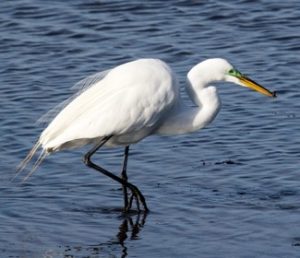
Freshwater tidal, brackish, and salt marshes are hallmark features for the coastal plain region of New Jersey and represent perhaps the most critically important habitat type for both ecosystem functioning and human health. These wetlands provide critical services that sustain lives and livelihoods, including flood protection against rising seas, maintenance of water quality, carbon and nutrient sequestration, and fish and wildlife habitat.
Coastal Wetlands: A Valuable Ecosystem
Wetlands are among the most productive ecosystems in the world. An extensive variety of species of microbes, plants, insects, amphibians, reptiles, birds, fish and mammals are part of a wetland ecosystem. Climate, location, landscape topology, geology, and the movement and abundance of water help to determine what plants and animals inhabit a wetland complex.

Once seen as either being disease-ridden places to be drained, converted to agriculture or dredged, filled and developed into lagoon communities, we have come to understand that coastal wetlands provide values that no other ecosystem can. These values include critical nursery habitat, natural water quality improvement, flood and storm surge protection, shoreline erosion control, opportunities for recreation and aesthetic appreciation and natural products for our use at no cost.

Wetlands also sequester more carbon than any other habitat in our region. That means that wetlands have the ability to store excess carbon (via photosynthesis) from the atmosphere. Plants extract the carbon dioxide from the air and use it in the photosynthetic process to feed themselves. The carbon dioxide enters the leaves of the plant through small pores called stomata. During this process, the plant combines carbon dioxide with water to allow the plant to extract what it needs for food. Since carbon dioxide (CO2) is one of the primary components of greenhouse gases and a driver of climate change, wetlands play a critical role in our future. Loss of marshes will have a doubling effect on carbon in the atmosphere, because such losses lead to a decrease in future carbon sequestration plus an increase in the carbon dioxide produced as the decaying marsh is metabolized by bacteria.
Why is Monitoring Coastal Wetlands Important?

Historically, no single entity was able to assess and track both the extent and condition of tidal wetlands across New Jersey. Consequently, only patchy, outdated, or inconsistent data were available on current wetland conditions, coverage and trends. This absence of comprehensive information hampered our collective abilities to provide watershed-scale guidance to natural resource managers and policy makers on how to best protect and enhance wetlands on a long-term basis.
Improved assessment and monitoring of this important habitat was imperative for numerous reasons: Healthy wetlands are one of the keys to clean water because they filter sediment and nutrients and sequester more carbon than any other habitat in our region. Most fisheries and shell-fisheries are sustained by tidal wetlands, which serve as nursery and foraging areas. Both migratory and resident birds and other wildlife depend on tidal marshes. A better understanding of marsh status and trends will help us to manage key living resources and healthy tidal marshes, which is imperative as we continue to address the impacts of climate change and sea level rise.
National Estuary Programs Filling a Need!

Following the lead of the State of Delaware, the Partnership for the Delaware Estuary (PDE) established a network of an integrated wetlands monitoring and assessment sites in 2007. In 2009, the BBP expanded the wetlands monitoring network into the Barnegat Bay, and together with PDE established the Mid-Atlantic Coastal Monitoring Assessment (MACWA).

MACWA utilizes a multi-tiered monitoring and assessment approach based on the US EPA monitoring wetlands guidance that includes remote sensing, Rapid Assessment, Long-Term Site Specific Intensive Monitoring, and special studies. The combination of this approach has helped us gain a better understanding of these complex systems.
A Cooperative Endeavor
The BBP and the PDE are closely working together with the NJ Department of Environmental Protection, EPA’s Region 2 and EPA Headquarters Offices of Wetlands, Oceans and Watersheds, The Academy of Natural Sciences of Drexel University, US Fish & Wildlife Service, and other partners. The BBP is a founding member of the New Jersey Tidal Wetlands Monitoring Network.
Our MACWA work to date has been possible thanks to grant-funded support from the US EPA (Region 2, Headquarters, and Atlantic Research Division), NJ Department of Environmental Protection’s 319 (h) Program and NJ Coastal Management Program, and NJ Corporate Wetlands Restoration Partnership. MACWA Related Reports
For more information or if you are interested in volunteering on the BBP’s New Jersey MACWA Program, contact Martha Maxwell-Doyle (732) 255-0472 x5 or mmdoyle@ocean.edu.

